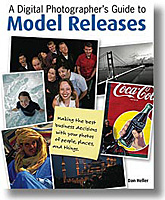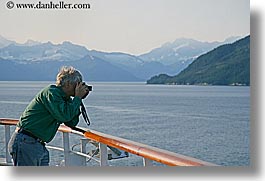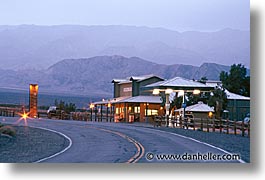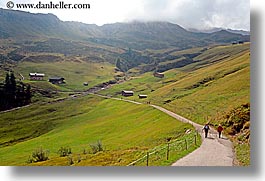|
Markers indicate locations for photos on this page.
Accuracy responsibility of Google Maps
Google Map Goes Here
If you see this text, the map is still loading (or there's an error). |
To score your knowledge, give yourself one point for each item you answered "Yes," and two points for each item you answered "No." In fact, make it three points. Now, total up all your points. If your score is above zero, you have a lot to learn about model releases. Yes, none of these questions have an answer at all. And no, these were not trick questions. The questions can't be answered because none of the scenarios indicate a use for the images. And by "use", we're talking about a form of publication or depiction of a person that would be affected by two kinds of laws: publicity and privacy laws. In the first case of privacy laws, courts have ruled that people have a reasonable expectation of whether (and how) others may observe them in some conditions, like inside their own homes. If you're at home, you have the right to not be viewed by anyone. If you're at the park, a concert, a bar, or even someone else's home, you cannot necessarily assume that no one there has a camera. In any of these conditions, someone could photograph you. This is what determines "privacy" in privacy laws. That's not to say they can do anything they like with the photos they take; it just means that they can, physically, take your picture. What people can do with those pictures is governed by publicity laws. Here, people have rights for how their "likeness" is used by others to promote ideas, products, services, or things. The tricky keyword here is "promote." The key test to determining whether a release is required is whether the person in a given photo can be perceived as an advocate or sponsor of those ideas, products, or services.
You might be thinking that it's because it's the newsworthiness of the event that permits this sale. But this is where public understanding begins to drift askew from the law. How do you determine newsworthiness? If you had a photo of some guy you took on the street, and the newspaper wants to buy it from you because they think this guy is about to be charged with a crime, and they want to be the first and only paper to run the photo. So they buy it from you in anticipation of the event. You might be totally unaware of who this guy is, or his alleged crime, and you can sell it to them, even though there may not yet be any news yet. In fact, there may not even be a crime, and the newspaper may or may not actually run the photo. In fact, newspapers publish photos of people all the time, often for unremarkable reasons. They are permitted to do so under the rights of "freedom of speech," covered by the First Amendment. And your right to sell them such photos is equally covered. On the other hand, we all know that a photo used in an advertisement needs a release because the person in the photo could be assumed to be an advocate for a product, service or idea. So, let's go back to the same newspaper scenario as above, and say the newspaper then decides that it wants to use that image in an ad promoting the newspaper. Obviously, the person in the photo would need to give consent for an ad. Who needs the release? The newspaper. It's the one running the ad. That they bought it from you has nothing to do with it. If they didn't tell you ahead of time, or perhaps told you they wouldn't, but changed their minds, or perhaps they did, but you were misinformed about the law, none of this matters to you, because you aren't the one publishing the image. You are not and cannot be liable for how other people publish images that you sell to them. The mere act of selling doesn't imply anything about anyone. It's the publication of the photo that may trigger the need for a release, and this is where "publicity laws" apply.
You may still be confused, and that's OK. I am by no means being
"complete" here. I'm just setting the stage to help get your mental
compass pointing in the right directions so I can dive into details later.
For now, you at least know enough to relax about several common myths:
"Selling" doesn't require a release, nor does it matter what the photo
is of that requires a release. It could be a recognizable person,
a building, a famous celebrity or landmark, a piece of art, someone's
home or property, their dog, or anything at all. None of these are,
by themselves, triggers for requiring a model release. If you have
already shot pictures, or you are about to shoot them, and you're
concerned about whether you need a release for the pictures you shoot,
the answer starts out no. It's only when the photo may be used in
some sort of publication, or other conditions to be discussed, then the
question can be examined.
As implied above, the need for a release may be necessary, depending on how the photo may be published. But this brings up the second most commonly perpetuated fear and myth about photography: that the photographer can get sued if the photo needed a release and the photographer didn't have one.
Since taking pictures doesn't require a release, nor does selling or buying photos, why do photographers get releases then? The answer is alarmingly simple: to increase the number of potential buyers. Because it's the buyer that (may or may not) need a model release for the photo, photographers get releases ahead of time so those buyers will be willing to buy those photos. Since the photographer happens to be taking the picture, it makes sense to ask the subject to sign a release. In short, you're just making life easier (and safer) for your clients, which helps your business. This does not mean that you have to have a release. How did it become a myth that photographers had to get releases? Two factors: first, the myth that "selling" photos requires a release, which itself started from buyers telling photographers, "we can't buy your images unless you have releases." They say this because the buyer (who's about to publish the photo) needs the release. But, the photographers misunderstand this, and pass the word onto one another as, "you have to get releases to sell your photos." The second myth is that photographers need releases of photos they use to illustrate their own work, which they need to do in order to make the photos available for sale. This has been mistakenly presumed to be a form of advertising. It isn't. Distribution of media for the purpose of selling it is not a form of publication that requires consent (a model release). More on this later. Now, it certainly can be the case that you promote yourself using photos you've taken of someone else, in which cases, there are certainly circumstances where you'd need a release from those people. Oddly enough, they are more unusual and nuanced cases to consider, so I defer that discussion to my main chapter, Model Releases. (This chapter is just the primer.) For now, let's review basics:
No photographer has ever been sued and found by a court to be liable for how someone else published a photo of someone. It's always the publisher that gets sued. But that's not to say that photographers don't assume some risk. So, let's take a look at that.
Now, that's not to say that the gun manufacturer or the photographer might assume some risk. For example, say the guy who used the gun said, "the safety catch was on, but the gun fired anyway." Here, he's trying to show that the gun manufacturer produced a defective product and can be held responsible. Alternatively, if the ad from the gun manufacturer said, "Go ahead! Shoot your friend in the face! It won't hurt him!" The the company could get into a lot of trouble. This is called an Estoppel Based on Fact. That is, if person A sells something to person B and assures him that it's ok to use that thing in a particular way, then person A can be held responsible if person B gets in trouble (or injured) if he acted in accordance with the advice. Here, the gun manufacturer can be held liable if they tell someone, "shoot your friend!" Of course, the gun manufacturer would never say such a thing. But photographers are not as judicious in their assertions of fact. If the photographer asserts his opinion as to whether a release is (or is not) required for any given photo, he is putting himself into legal jeopardy if the publisher ends up taking his word for it and gets into trouble. This is true regardless of whether the photographer says "yes, you need a release," or "no, you don't need a release." The best thing to do is say nothing. You can't (and shouldn't want to) know whether any given use would require a release; this is not your business to know. And by all means, never give the publisher reason to "rely" on your opinion. Chances are, you're wrong about whether a release is required for the buyer's use. (How well did you do on the survey at the top of this article? Hmmm?) Most photographers assume that the conservative assumption is always the safest—that if you have a release, you're always protected. Therefore, they usually advise other photographers, "It never hurts to ask for a release." This is not always true for many reasons. One reason is that, by asking for a release, the nature of the photo can transform from that of a "candid" shot (where the subject is unaware of your taking a photo) to an "orchestrated" shot, one in which the subject is taking direction from you, such as how to pose, look, etc. As you edge ever closer over giving full and explicit direction, you may inadvertently represent the subject in a way that he would not approve...and wouldn't know it till much later after the photo is published. If it were a candid shot, there's one set of conditions that could protect you from his claims, but if it's an "orchestrated" shot, then the law presumes an entirely different set of conditions. If you have him sign a release that doesn't reflect orchestrated nature of the photo shoot, then it may not protect future uses of the photo that your licensees may use, thereby getting both you and your client into trouble. (Think of licensing one of these photos to a hospital producing a brochure seeking volunteers for a study who are HIV-positive.) For a longer discussion on this, see this article. Another peril to always taking the conservative approach is that case of Estopple Based on Fact, as discussed above.
Years later, the non-profit produces ads with this guy all over them, and it turns out he's a lobbyist for a tribe of native Alaskans who kill whales as part of their rituals. They get upset with the guy and fire him, causing him to lose all his income. So, he files a claim against the non-profit, claiming that the release he signed wasn't broad enough to include the kinds of representations the company implied with the photo of him. Now, you're stuck because you now realize you know zilch about the law, and the boiler-plate model release you copied from the internet was a piece of junk, and now you're on the hook because the company has implicated you because they relied on your statement that a release was necessary and that yours would suffice. But, now they've suffered detrimental consequences. And so shall you. Had you left well enough alone from the outset—that you made no claim or representation that the company needed a release for the photo—then the company would have had a representative contact the man and had him sign their release. Even though that might not really have saved them, you wouldn't be on the hook.
The lesson: you can speculate all you like as to whether a photo needs to be released, and it's wise to be as informed as possible, but your entire objective is to absolve yourself of responsibility. And the best way to do that is to assume nothing and don't "say" anything. Fortunately, you start out in life absolved of responsibility. That's right, unless you actually do or say something, the law doesn't even look at you in the case of a dispute. It's only when you open your mouth and say something do you begin to slide down the hill. So the best thing you can do is say nothing. Or, better yet, specifically say that you are saying nothing about whether any given use does or does not need a release. If you say anything other than "I don't know" (to the question of whether a given use requires a release), you are rendering an opinion that the licensee can later use against you. Why are you safe "by default?" Because, as I mentioned earlier, photographers are not in ultimate control (or even in full knowledge) of how their images are used once they leave their hands. If you license a photo to someone for a particular use, and the buyer ends up using it only slightly differently than how it was represented to you, then you can't be held responsible. No matter how close to the "actual, disclosed and formally stated use" you can get, nothing suddenly transfers responsibility to the photographer (or whoever sells the image) because of how the buyer published the image.
In short, the law does not require the photographer to defend against
the use or misuse of a photo that another party may do with it. And the
best way to make this fact unambiguous to the licensee is by disclosing
whether the photo is released, and that you make no claims of its
usability in publication. So you state, "I make no representations
as to whether any specific use of the image requires a release. You
(the licensee) assume that responsibility. I can only say that I have
(or don't have) a release that is transferable to you."
In any event, it is the publisher's responsibility to demonstrate two things: that they acquired the image legally (presumably from you), and that they are in compliance with the terms of how the image was used. Of course, all of this is predicated on the assumption that a release was actually required in the first place. In most cases, that's a subjective assessment, and quite costly to pursue to its conclusion in court. Threats may go back and forth, but the parties almost always resolve the question quietly on their own. If a release is required, then let's follow this thread of questions:
The first question is a no-brainer and doesn't need discussion. As for representation, consider a photographer that advertised his own website using banner ads on other websites with the phrase, "For a limited time, use any image for free for any use." Someone picking up those images may go ahead and use them in a way that would require a release. So here we have an example where a photo is out there, the photographer gave broad implicit permission to use it, and a publisher picked up on it. If the subject of the photo decided to sue the company that used it in an ad, the company would try to bring the photographer into it by citing his blanket statement of use. Here, the judge has a decision to make: will he see the photographer as naive, and the publisher as sophisticated? If so, he'll slap the publisher for believing a dubious claim by a naive photographer. On the other hand, if the judge sees that the photographer as a sophisticated businessman with an ongoing business licensing photos, he would deem his statement as a negligent misrepresentation of the usability of his photos. (There have been some now-extinct stock agencies that have used this very technique.) Now, let's consider possible answers to the other questions and discuss them. "Did the photographer inform the user of the release status of the image?" Possible answers:
If the user didn't think a release was necessary, he's still responsible because it's the "act of using it" that matters. In other words, whether it was a misunderstanding of the law, or an intentional violation, it's his fault. So long as the photographer notified the user that he has no release for the photo, it's entirely the responsibility of the user to understand the limitations of the photo's use.
Here are some ways the photographer could find himself in some warm water: the possibility that the photographer hampered attempts by the publisher to retrieve the release. Remember, again, that the publisher is considered ultimately responsible for knowing what they're doing, so it is incumbent upon them to make (legal term here) "best efforts to assure legal compliance." Sometimes, you may hear the term "reasonable efforts." Here, the publisher would have to convince the judge that they made (what the judge believes to be) sufficient attempts at getting a copy of the release, but they were rebuffed. For example, they could claim that photographer said, "yes, I have a release, and I'll send you a copy of it," but failed to do so. The judge could reply, "then you shouldn't have taken the risk; that's your fault." But maybe it was one of hundreds of photos obtained by the photographer, and the releases were provided for all the other photos. The publisher could claim that this one was simply overlooked and that there was a reasonable assumption that the photographer was telling the truth about this one. This is where the term "reasonable efforts" differentiates from "best efforts." In the scenario I described, a reasonable effort was made because "reasonable assumptions" were made by the fact that 9 out of 10 releases were provided, and they were in order. However, if the judge wanted to use the "best efforts" definition for this particular case (if the nature of the subject suggested that someone could be seriously harmed if the photo were published without permission), then much more punitive damages could be awarded to the plaintiff. And this might also implicate the photographer even more. This all revolves around the hypothetical case where the photographer actually hampered the publisher's efforts to get the release, or that he made misrepresentations that the publisher couldn't have seen. So again, if the photographer disclosed the true status of a photo's release, then none of this would apply.
Let's not dismiss a very obvious possibility that the photographer lied. With the advent of many microstock photo sites and other agencies accepting millions of images from millions of people, the lure of easy money can find many people submitting images with claims that they have model releases when, in fact, they don't. Because of the rarity in which real lawsuits happen due to unreleased photos, it's not a stretch to envision some people forging what appear to be legitimate releases knowing that there's little risk. Here, the photographer is clearly the liable party legally. And yet, even that might not get the publisher entirely off the hook. Though the judge may apply different standards depending on the circumstances of the case, he usually leans more on the publisher than the photographer. NOTE: lying about having a release (if you don't) is a matter of "fraud," which is a federal crime. You don't get sued by an individual (civil crime), you get prosecuted by the government. This has nothing to do with publicity laws or anything else discussed here. You don't get out of it by later getting a release. Committing fraud (lying for the purposes of obtaining money) is a very serious offense in the USA. Another sort of scenario may also arise: say the publisher coerced the photographer. Suppose the publisher got the image from someone's personal website, where it's clear that the person isn't a pro photographer or has any awareness of such issues. If the publisher said, "if this person told you you could take his picture, you are allowed to license it to us. Are you sure it's ok?" Clearly, this is wrong advice, but the guy may simply not know, in which case, the judge would look at that and see mal-intent on the part of the publisher.
As evidenced by the above examples, there are many possibilities that
could shift the ultimate liability from one party to the other. In
a lawsuit, the judge's job is to unravel it all. But in the end,
the party who puts the image into publication carries the liability,
so it's their responsibility to know (and to enforce, if necessary)
whether the image is properly released for that usage. The only time
the photographer could be held responsible is if it can be shown that he
willfully misled or covered up information from the publisher that could
have prevented the act from taking place. Because the photographer's
liability is so limited, and because his responsibility is so narrow,
the best thing for photographers to do is to simply disclose.
For example, many photographers assume they should license no image that is not released. First, that's a bad business decision because there are infinite numbers of opportunities to sell images in situations or conditions that don't require a release. So, it should be part of your modus operandi to shoot as much as you can, simply because the more content you have, the more business opportunities you can yield. On the other hand, there is value to having photos released, because that opens up licensing opportunities beyond the editorial market, which also expands your business. So, you should get releases when you can. Needless to say, it's easier to get a signed release at the moment you take a picture than it is to hunt down the person later. That said, "when you can" is not an easy assessment to make either. Don't just assume you need to go get a release just because you took a picture of someone. It's a time-consuming process to be constantly asking people to sign releases, which can interrupt the photo process for many. Choosing to take a time-out just to get a release needs to be weighed against the commercial potential that the image has. Pragmatically speaking, this is actually much rarer than one thinks—selling pictures of recognizable people can be quite profitable, but typically involves a business infrastructure that penetrates a relatively narrow industry segment of higher-end advertising clients. To those who don't think it's costly in time and resources to bother getting releases in public stock photo grab shooting, you're not shooting nearly often enough, or fast enough. No question, there's a social aspect to it that many people enjoy. But that's a lifestyle argument, not a business case. So long as you understand the difference, you're fine. Also, you should remember the perils of getting so involved with the photo subject that the shoot becomes less candid and more "orchestrated." Again, see this article for additional discussion. When an opportunity comes up for you to license an image to someone, it doesn't matter whether you have a release, it matters that you inform the client. So, your "modus operandi" is quite simple:
As long as you fully disclose what you have, you are not liable for how
the client may use the image.
Great question, and that alludes to my statement earlier, when I cited the case where the photographer may be complicit by neglecting to stop a crime from being committed. But, it's rarely going to be as black and white as that. There are far more cases where you're going to be wrong in your assessment about whether releases are required, so you don't want to (nor would be expected to) adopt an overly defensive position. Because legal liabilities often come down to intent, a judge is going to look at your normal business practices—your modus operandi—and determine whether you're doing anything out of the ordinary. The business reality is that you never want to engage in legal speculation (or discussion with a client) on subjects that you are not necessarily qualified to speak authoritatively. The usability of any given photo is a legal question, and every publisher needs to have their own legal representatives advise them on these decisions. If you begin to render an opinion on the matter, regardless of how clear-cut it may appear to you, you open yourself up to Estopple of Fact, and your words may come back to haunt you. This is not a question of "ethics" or even legality—it's a business operations rule that you do not advise others on how to run their businesses. Because the thrust of this article has been that you are not responsible for how an image is used (that the publisher is), you could extrapolate that you technically don't really need to know any of the nitty-gritty details of whether any given use of an image may require a release at all. In fact, you could hypothetically just go on your merry way without ever knowing anything about the legality of image uses. (In fact, since most photographers are uninformed about these issues, they almost already do go on their merry ways without ever knowing anything about the legality of image uses.)
That said, the advantage of knowing when releases are required is if you
are building a business selling images to the commercial market. And here,
this isn't to protect yourself, it's so you have a better understanding of
how to draft various kinds of releases for various uses. This is how you
capitalize on business opportunities ahead of other photographers. Since
different uses may require different terms within the release's language,
you may wish to familiarize yourself with the varying conditions in
which releases may be required so as to help in your marketing efforts.
(For that discussion, see Model Releases. But don't leave this chapter yet.)
As mentioned repeatedly, your first line of defense is: inform the client of whether you have a release, and if necessary (or if they ask), what that release says. If they screw up from there, or are sued inappropriately by an unscrupulous third party, they're on their own. It should come as no surprise that publishers already know this. In fact, they are one step ahead of you, which is why some companies present you with their own license agreement to sign when they buy an image from you. In it, there's a section titled, Indemnity, also known as the "Indemnity Clause." This section usually says something like, "you warrant that the photo is free and clear of any restrictions, and that you carry the responsibility if it isn't." Of course, the real wording is usually much longer and uses fancy legalese type language, but that's the gist of it. Here, if the subject of a photo were to make a legal claim against the publisher, the publisher will then come to you and say, "You have to protect us in this lawsuit." This translates to "you pay our legal bills and any damages that may come from a lawsuit, regardless of the circumstances."
On the other hand, if you were a large stock photo agency, you probably have a large legal team, and that's why these indemnity clauses are there: to make sure stock companies are held to account for the content they get from their photographers. Thus, the standard procedure taken by most companies who license images from stock agencies is to have them sign these indemnity clauses. It's much different for an agency to warrant their products than it is for a single photographer. So, if you're presented with such an agreement, understand that you're just being tied up in a higher-level of legal wrangling of other parties, and that you don't need to worry so much.
The estate of James Brown sued Corbis for selling unreleased photos of him to licensees that used the pictures in commercial ways. The uses of the photos required a release, but the question is whether Corbis was permitted to sell such unreleased photos as well. While this case was never adjudicated because the parties ultimately settled out of court (after appeals that didn't appear to favor either side), my interviews with legal scholars, reporters and judges who were familiar with this case felt that the case would not have changed the current law—that sellers have any liability for how publishers use (or misuse) images of others. The primary issue they cite is the countrary argument: if sellers were in the position of being held accountable for how a buyer published an image, publisher's would no longer bear such responsibility, and the rate of violations would skyrocket. If someone tried to bring a claim against the publisher, that publisher would point to the Corbis case as precedent: they would claim that because the image was sold to them, it must have been ok to publish. If it wasn't ok, then it's the seller's fault. That's what Corbis vs. Brown would have resulted in, and no one believes the courts would have permitted that. Furthermore, the legal scholars I interviewed for this also say courts also don't want non-liable parties in a position of making complex legal decisions on behalf of people they don't represent. Therefore, all legal analysts I've ever interviewed on this subject feel confident that the Corbis case would not have gone against them. That there is no other case where a seller was held liable for how a publisher used an image, it's reasonably assured that making an image available for sale does not require a model release. This includes any and all forms of publication and media, whether it's traditional print or online formats, including personal web pages, photo-sharing sites, social media sites, stock photo sites, or anywhere. That some agencies won't accept unreleased photos from photographers is unfortunate because unreleased images have a lot of licensing potential, for both commercial and editorial uses.
Since many large media companies have a lot more money than people like
you, chances are that if a company is sued for how it used an image
that it obtained from you, your involvement will be minimal. The lawyers
filing the suit are going to ignore the company's attempt to bring you
into the picture for long. You will be called to give a deposition
about what you disclosed to the publisher about the photo and its
release status, but short of that, the opposing lawyers are going to
focus all their attention directly on where the money is: the publisher.
They may make many allegations (perhaps some without merit) about how the
publisher used the image in inappropriate ways that supersede whatever
may be in the model release. And if a release doesn't even exist,
they will claim the publisher was negligent in determining this fact,
and claim even more money from them. So, this process is going to
require the time and attention of the publisher's lawyers, which will
almost certainly end in a financial settlement that won't involve you.
How do you bolster your exemption from liability more than what is already afforded you by default? You can do it using the same method they used: the indemnity clause. That is, you have them sign an agreement that acknowledges what you told them about what you have (or don't have). At face value, this seems like a good idea. Problem is, companies are unlikely to change their existing agreement, especially in a way that has them assuming even more liability than what they already have. You can introduce your own contract that has this clause, but they aren't going to sign your agreement if they already presented you with their agreement.
Those photographers that use their own license agreements can add their
own indemnity clause. However, this gets into the more "involved" topic
of contract analysis, which is beyond the scope of this discussion.
In general, I caution photographers who have their own license agreements
to try to avoid being too verbose in its content. The more legal
language you add to an agreement, the more it can be construed that you
are waiving your existing rights (which are very strong and pervasive),
and replacing them with those spelled out in your agreement. You don't
want to rewrite or restate the laws that already protect you, so be
careful in this area.
Normally, this isn't much of an issue, but with the internet and certain kinds of publications (print-on-demand, for example), people publish and distribute material all the time, never knowing whether they cross over into that gray area where permission may be required of someone. Or something. Take the case of The Black Mustang Club, a private group of car owners, who produced a calendar featuring member's photographs of their own cars. The sold the calendar through Cafe Press, but Ford got Cafe Press to stop selling the calendar, claiming it infringes on Ford's trademarks. Photographers expressed outrage online and the mainstream press picked up on the news, making it appear that it was illegal to take pictures of one's own car. No, that's not the case. There was nothing wrong with the photos themselves, or even the printing and distribution of those photos. The problem was the use of Ford's logo, and it is that issue alone. The claim was that the logo was used in such a way that might have triggered one or more of the following: that Ford produced the calendar, or was closely affiliated with its production, or approved it, or that its logo was being used by another entity in order to commercially profit from it without permission. Now, these are merely "claims"—they are not established facts, nor had a judge ruled on the claims to uphold or dismiss them. Before getting into those details, let's step back for a moment and understand the legal conflict at hand. The First Amendment to the US Constitution protects free speech in ways that does not require consent from others, whether it's their photograph, or their trademarked item, such as a company logo. Examples include artistic presentations, critique, praise, commentary, and so on. On the other hand, individuals can protect their likeness (photos of themselves) or their creative works (such as copyrighted works or trademarked logos) from "infringement" for certain kinds of uses that are not protected by free speech: commercial uses. This is not an easy, clear definition, but rather, a series of triggers that must all come together in ways that must be taken together. In short, there is no red line to cross. Commercial use is a very wide, gray and ambiguous spectrum, and the law tends to favor free speech when in doubt. This is where the question of distribution comes up. Now, simply making money is not considered commercial use; it is possible to sell individual works of art depicting logos and trademarks. Artists sell their works all the time in many forms of artistic mediums, from written texts to paintings to photographs to sculptures, and so on. In such forms, artists can make many copies and sell them as well. But the more they make, and the wider the distribution, the more it blends into that territory of "commercial use" and the lines on First Amendment protection begin to blur, and the protections of the people on the other side begin to take precedent. Movies, television shows, and other works of wide commercial distribution are examples. Yes, they are creative expressions, much of which is protected by the First Amendment, but they are also commercial works, which means that consent from some individuals for the use of their likeness or logos may be required. Again, these are not clearly delineated lines—both can be true at the same time, and the law must be assessed on a case-by-case basis. That's why we have courts, lawyers and judges.
As a personal speculation on my part, I believe Ford had a pretty strong case, and if the matter were litigated, it would probably have prevailed. This speculation on my part should have no bearing on your understanding of the law. Rather, it is intended more to focus your attention on the fact that this wouldn't have come up had it not been for the wide distribution of the poster beyond the small group of car-owners who, for years, had produced the poster without contest. Coming full circle, there are two ends of the spectrum: on one side, the use of the logo is not an infringement if used for personal projects. On the other end, the mass publication of the poster is "distribution." Somewhere along the way in the middle is where the line was crossed. Many people find themselves in similar situations: they sell personal works of art, or provide interesting photo services or projects that may involve trademarked properties, or faces of recognizable people. Do these uses require releases? The answer is never a clear yes or no, but a series of analyses on facts and circumstances, which then have to be weighed as a "scale of risk." This is a fancy way of saying, is it really worth someone bringing a lawsuit against you—which can be expensive—for a legally ambiguous claim that has no financial upside to winning? It is almost universally true that individuals bear no risk at all, not just because the financial risk is low, but it's also because individuals usually do not engage in the form of infringement that isn't well protected by the First Amendment: art and expression.
The financial risk increases if the money involved is large, usually
at scales that are not easily achieved by individuals. Larger
companies are usually more the targets (hence, Cafe Press). But that
doesn't necessarily mean the legal risk increases proportionally. The
two often have nothing to do with one another.
When it comes to displaying images in these ways, the laws that apply here are not commercial in nature, but that of civil liberties. In general, the question to ask is whether you are portraying someone in a negative manner that a reasonable person might find offensive. Did you break the law in obtaining the images, like planting a hidden camera in their house, or using a telephoto lens to do the same? Is the photo slanderous, or suggests an untruth in a way that harms their personal or professional reputation? And then there's the question of photos displayed on your website. Here, the question is both easy and complicated. The easy part is for photographers who post photos on websites for the purpose of selling/licensing of images. This is not a form of publication that requires model releases. The courts call this a "vehicle of information," and has been established by the Illinois Appellate Court in this document. (This is discussed in more detail in Model Releases.)
This came up before in the discussion regarding the photo studio in the mall, where the display of the photo in the window was a form of promotion for the business because it is the place of business. This is a differentiation from "illustrating" your work, which is not a form of publishing that requires consent? The difference is, once again, the pivotal lesson of this whole chapter: whether the depiction of the photo implies that the people in the photos are advocates or sponsors of your business. This is often a fine line, but it's easy to draw extremes. If you display the images along with a flattering testimonial about, then that is definitely a use that would require consent—a model release—from the subject. On the other hand, if you have a website that has thousands of thumbnails of images on a single page, and they are all full of random people, and the site simply says, "pictures of people I took on vacation," where is clearly no implied advocacy by these people. No one is going to presume that anyone "advocates" the photographer. They may or may not be happy about their photo being online, but they can't stop that, nor do they need to give consent for that. Determining the distinction between advocacy or illustration is context. That is, the act of "promotion" usually involves a call to action, such as "buy this!" or "call us!" A "illustration" of your work may be merely the presentation of images on your website. As a matter of course, websites often are just that: presentations, which themselves never require model releases.
Since the web can be ambiguous, where sites both "illustrate" work, and
have portions with promotional elements, the easiest way to assess any
given image on your site is to ask yourself whether an objective
observer would consider that person to be an advocate or sponsor of
you or your business.
The bottom line is one that I've repeated many times here: if you are honest about whether an image has a release, and the client has been notified of this, then you cannot be held responsible for anything the client does with that picture, including using it in an ad or any other form that would require a release. You have no control over what they do, and therefore can't be held accountable for their actions. The purpose of getting a model release signed is not so much to protect yourself, but it's to generate more business opportunities with that image. Publishers like licensing released photos over unreleased photos. While unreleased photos have a more limited audience, it's not substantially so. There is still a large market for photos of people to be used in editorial contexts, so it is unwise to only license images that have been released. It should be emphasized that different publishers vary in their own assessment of any given use, so don't extrapolate what one person thinks as legally "necessary" or "correct" about whether a release is necessary to another. In the end, it shouldn't affect your business decisions. Rather, it could affect your marketing decisions—whom you market to may be more attracted to released images, and vice-versa. Further, do not assume that what a client does represents a de-facto standard throughout the industry. Lastly, you may entirely disagree with the publisher on their interpretation of whether a release is required, but again, this isn't your job. All these fall into the reality that photo buyers' rationale for requiring a release is not necessarily based on the law. It may be just a reflection of their own risk assessment—they don't want to be sued at all, and it's safer when using only released images.
Acquiring the most content as possible is critical to building a viable stock photography business. Get releases when you can, because this makes life easier later. But if you can't, don't let this slow you down. There's no question that your best opportunities arise when you have signed releases for pictures of people. But, since that's not always possible, it's short-sighted to be too conservative and not shoot, or even avoid displaying, unreleased photographs of people. When a client comes to you for an image, let them determine whether it needs to be released. To learn more about when model releases are actually required and other business concerns surrounding it, see Model Releases.
Click to recommend this page: |
|






















